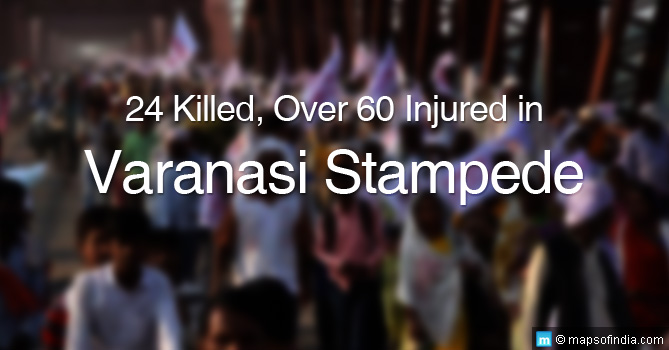The festive month of October 2016 witnessed yet another horrific human stampede in the outskirts of the holy city of Varanasi. The tragedy occurred when a large number of followers of one Baba Jai Gurudev were making their way to a two-day religious camp at Domri on the banks of the Ganga.
The incident took place on the famous Rajghat Bridge, which simply couldn’t take in the excessive crowds. The sheer human pressure took its toll leaving 24 people dead and over 60 injured, which included 20 women.
This is the same Baba Jai Gurudev whose unruly and violent followers led by one Ramvriksh Yadav had clashed with Mathura Police some months back when they were asked to vacate government land that they had illegally occupied.
The state government was quick to announce Rs 5 lakh ex-gratia payment to the next of kin of the deceased and Rs 50,000 to those who were injured. Prime Minister Narendra Modi, who also happens to be the MP from Varanasi, too announced Rs 2 lakh compensation to the families of the deceased and Rs 50,000 for those seriously injured.
Given the election year, several political leaders were quick to announce their condolences and condemn the state administration for failure of administration. But none have done anything over the years to ensure stampedes don’t occur in the first place.
This is not the first such incident nor is this the last stampede that India will witness. Each such tragedy is followed by the usual cash announcements and setting up of a judicial enquiry, with a few police suspensions or transfers that follow.
Inaction leads to callousness
It is appalling to the point of criminal negligence that successive governments at the state level have been allowed to get away with sheer callousness and lack of responsibility for the tragedies that have occurred over the years. One never hears of any action taken against any top political leader, Member of Parliament or District Magistrate of the area under whose jurisdiction the incident takes place. Besides a few suspensions or transfers, there is absolutely no accountability or action taken on any report or outcomes of these judicial enquiries.
The principal cause for this total apathy to human life is the complete lack of political interest in trying to prevent such tragedies and this is further fuelled by a callous state administration, which simply passes the buck from one department to another with total nonchalance.
Both classes know fully well that they remain immune from any serious action that may negatively impact their career or even send them to jail. It is this lack of fear due to subsequent inaction that we see repeated tragedies occurring with no lessons learnt.
Unfortunately, we as a nation too have become immune to mass tragedies resulting in loss of human lives. They occur with such frequency that people have become de-sensitized to the issue and carry on with their daily lives without putting pressure on the government to take action against erring politicians and officials.
Proper planning has yielded positive results
Crowd management and control is not rocket science. When there is a will at the political level it is backed up well by a proactive state administration, as was seen during the Kumbh Mela in Nashik in 2015. The same venue in 2003 witnessed a stampede that killed 39 and left several injured.
In 2013, the Kumbh Mela in Allahabad witnessed yet another stampede resulting in the death of 36 people, including 26 women, and leaving 39 injured. It must, however, be added that no incident took place at the mela itself, which was well organized. This incident happened at the Railway station when a railing of an overhead footbridge collapsed.
Both in 2013 at Allahabad and 2015 at Nashik, the state administration did a good job during the mela. These melas handled much larger crowds but due to good planning and coordination between state administration and Police, and backed by adequate deployment of manpower, they went without any major incident.
So, if it is possible for these melas to function without a major incident of stampede, why don’t all state administrations learn the from these events?
The fact is that Standard Operating Procedures (SOPs) for Disaster Risk Reduction are already in place and information is available with all state governments. It is carelessness and lack of focus on part of the political establishment that allows the state government administration to become equally callous about crowd management. They are also handicapped due to lack of adequate funds required during such events and lack of adequate human resources required to manage crowds efficiently.
Between 1954 and 2012, there were 34 cases of major stampedes reported, with most incidents occurring in Kerala, Madhya Pradesh, Gujarat, Uttar Pradesh, Jharkhand, Odisha, New Delhi, Maharashtra and Tamil Nadu. It is indeed sad that there have been multiple cases of stampede at the same venue but little seems to have changed as people continue to remain at risk.
Main causes of human stampede
Studies of stampedes in India have revealed that 79% of total deaths have occurred during religious gatherings, 18% during miscellaneous gatherings and 3% during political gatherings.
The main causes are:
- Jostling, pushing and trying to enter closed or narrow spaces resulting in human pressure being concentrated on a few who ultimately suffocate and get crushed.
- Rumours that cause fear and panic among people.
- Natural events like rain resulting in slippery surfaces that trip a few people while others simply fall under the pressure.
- Collapse of temporary structures such as bridges, railings, pathways or sometimes canopies.
- Sudden rush to receive gifts and handouts, especially at religious or political gatherings, resulting in stampede.
- Sudden announcement that forces people to move in another direction in a short time.
- Stampedes also occur during the start or during close of large events.
Disaster mitigation measures that are often not followed:
- Evaluation of request to hold the event based on suitability of venue, capacity of the venue, ability and commitment of organizers to restrict numbers as per approval, safety measures to be undertaken, history of events at the same venue and prevailing and anticipated weather conditions expected during the event.
- Once approval has been granted, close coordination between event organizers, state administration, Police, Fire Department and Medical Services needs to take place to allocate role and responsibility for each stakeholder. This must be followed by frequent reviews with all stakeholders leading upto the event.
- Crowd management measures to include; establishment of central control room and central camera surveillance monitoring on round-the-clock-basis, adequate mobile-radio communication between volunteers-management team of the organizers- government officials present at site and Police, establishing crowd control barriers for smooth movement for entry and exit, setting up information booths and crowd guidance points throughout the venue, adequate signage guiding people to various points in the venue including toilets, police booth, information booth, medical relief points, food and water stalls, etc. and an effective public address system.
Review of large events like Kumbh Melas have revealed that when they remain incident free it is mainly due to good planning, coordination and following up on the above mentioned measures, the contrary of course resulting in stampedes. The SOPs are all laid down but rarely adhered to.
When will India learn?





